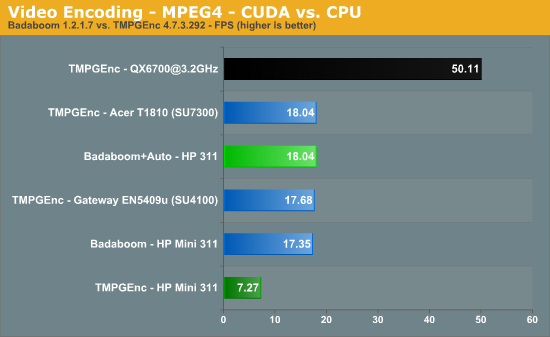HP Mini 311 — CUDA on ION
NVIDIA always likes to tout the advantages of their GPUs and CUDA. In theory, if you have a highly parallelizable task like video encoding/decoding/processing, you can accomplish that task a lot faster on a GPU than on a traditional CPU. When you add in the fact that Atom is already a very slow in-order architecture (albeit with Hyper-Threading), boosting performance of certain tasks could be very beneficial.
One of the applications NVIDIA talks about a lot with relation to CUDA is Badaboom. We haven't looked at in quite some time, and with the low performance of Atom CPUs it might be a viable option. We ran a test encode using Badaboom and a 720p source video, targeting the default "YouTube" output: 640x360 with 1000kbit VBR video and 128kbit MP3 audio. We also tweaked the Badaboom settings to enable auto key frame insertion for improved image quality and performance, which we'll see in a moment.
We can't run Badaboom on CPUs, unfortunately, so we used TMPGEnc 4.0 Xpress and similar settings: MPEG4 1000kbit video with 128kbit AAC audio. Interestingly, TMPGEnc also supports CUDA. However, the encoding is all done on the CPU, so the main benefit of CUDA for TMPGEnc is if you use some of the complex filters like noise reduction and smart sharpen. If you're just doing a straight video encode, CUDA doesn't appear to help TMPGEnc right now.
First up, here are the results, with CPU encoding time on an Acer Timeline 1810 as well as a desktop Core 2 Quad 3.2GHz thrown in for reference.

Badaboom ends up being about 2.5 times faster than doing the video encoding on the Atom N270. Hooray! It's also about the same speed as a Pentium SU4300, but an overclocked Kentsfield 3.2GHz CPU is still 2.8 times as fast. Can you do basic video encoding on the ION LE with Badaboom? Yes, but now let's discuss quality for a moment.
The highest quality encodes will always require multiple passes in order to provide a better analysis of how to best use the available file size. Badaboom doesn't support multiple passes, so we did a single-pass encode in TMPGEnc for comparison. File sizes are similar (4213KB TMPGEnc vs. 4205KB Badaboom). Below are the image captures of the encoded video.

Default Badaboom YouTube setting

Badaboom YouTube setting with Auto Key Frames

TMPGEnc 4.0 Express — Single pass MPEG4 AVC 1000kbit VBR (3000kbit max)
The initial encodes using the Badaboom YouTube defaults are, at times, horrific. The content of the source video (and the scene in particular) can make a big difference, but overall the default settings fail to produce optimal results. Fast motion content is the worst offender, but then doing a good compression of fast action content has always been a lot more difficult. Luckily, we determined that making one change — setting the Key Frame Mode to "Auto" instead of "Fixed" (with the default "Baseline" and not "Main" mode) — results in a much better image. We still give the quality lead to TMPGEnc — and if you do multiple passes, the gap widens — but as a compromise the CUDA-based Badaboom encoder can achieve some decent results. As for ION, it's not really fast enough to make CUDA compelling; a moderate CPU can easily produce better results. Move to a faster GPU (NVIDIA's GTX 260M does the same encode at around 82 FPS and GTX 280M is at 100 FPS) and CUDA can flex its muscles.
There are other concerns with Badaboom, however. We had quite a few sample videos that it wouldn't accept (including a standard MPEG2 video). We also had some issues with audio glitches — our test encoded video has a couple small gaps in the audio, and they're there every single time on multiple systems. It's a relatively easy to use tool, but ultimately it can provide encoding performance at the cost of flexibility and quality.
There are other CUDA applications, of course. We'll look at SimHD DVD up-sampling in our battery life tests for example. Another potentially useful tool is called vReveal, which can remove noise, improve contrast/lighting, and reduce shakiness in recorded videos. If you make videos with your cell phone or inexpensive digicam and you want to upload them to YouTube, vReveal might be worth a purchase. A better video recorder would be an even better purchase, of course.
Most of the CUDA tools at present focus on video (and to a lesser extent image) related activities, since these tend to be highly parallelizable. Anyone doing video editing/encoding work will want something far more powerful than an Atom-based netbook, even if it does have ION to help out. Ultimately, while CUDA is certainly interesting, we prefer a vendor-agnostic approach, and DirectCompute will hopefully provide that in the coming months (or years). We also need to maintain a balanced system — certain tasks still rely heavily on the CPU and aren't candidates for GPU acceleration — and Atom is nowhere near fast enough for a modern computer.










51 Comments
View All Comments
hybrid2d4x4 - Tuesday, November 24, 2009 - link
Excellent review! Looks like you hit all the important points and I like how the game selection is more relevant to this class of notebook. IMO, this raises the bar for comprehensive notebook reviews. Kudos!OhHenry - Monday, November 23, 2009 - link
How come they don't give smaller SSD like 32GB or 40GB as an option. I honestly don't need 160GB for a netbook; I do not know what to even put on it. They offered a 80GB but it was quite expensive. On a second note, wouldn't a SSD increase the battery life as well?chrnochime - Monday, November 23, 2009 - link
Are you sure the samsung nc510 has the DX10 ION? Read elsewhere that the NC510 also has the ION LE, something about keeping the cost down.piroroadkill - Monday, November 23, 2009 - link
You end up paying more for Ion, getting worse battery life, and still have completely useless gaming performance.Seems like a lose-lose to me. I guess it's useful for video acceleration, but that seems like a pretty fringe case for a netbook
araczynski - Monday, November 23, 2009 - link
looks like exactly the kind of junk HP likes to push at a price point that would leave anyone with half a brain scratching their head, wouldn't have expected anything more from them.Jaggins - Sunday, November 22, 2009 - link
I would like to see if an older game like Eve online or WOW would run on these ION netbooks.Lunyone - Monday, November 23, 2009 - link
I think they would be fine, just only when you get into RAID situations (or where there are alot of people and things going on). I think normal solo/small group playing should be fine. I haven't experienced it myself, but I used to game on WoW with a P3 800 mHz w/onboard graphics (Intel Extreme II, I think). Now mind you this was before the first expansion and the laptop wasn't all that special either, but the Atom would be about equivalent to a p3 at 1.6 gHz (if my reading is right).therealnickdanger - Tuesday, November 24, 2009 - link
Great article, I was contemplating buying this, but now I'm not so sure. My ONLY gaming requirement is Halo PC (multiplayer). It's an old game, but has some quirks when it comes to its demands on CPU performance. So I really need to know what the 311 can do with this game. I'll mail you a copy if you'd like.The game also has a timedemo mode. Just add
-timedemo
to the command line. It takes about a minute to rum.
Devo2007 - Sunday, November 22, 2009 - link
A few days ago when ASUS announced their new dual-core Atom-based netbook, I ended up thinking that a CULV-based laptop would be a better idea (especially since that netbook has a 12" display, and only a 5 hour battery life).Good to see I'm not alone in this line of thinking. :)
JarredWalton - Sunday, November 22, 2009 - link
Exactly. This isn't really for you, but for anyone else reading that's still wondering I've got numbers. The review is still pending, but just as an example:Acer Timeline AS1810T-8679:
"63Wh" battery (11.1V, 5.27Ah/5600mAh)
Core 2 Duo SU7300 (1.30GHz)
4GB DDR2 RAM
320GB HDD
Cost: http://www.onsale.com/p/5887001?dpno=7958665">$600
Battery Life
Idle: 592 minutes
Internet: 461 minutes
x264 720p: 259 minutes
Internet Minutes/Wh: 7.42
TMPGEnc MPEG4 CPU Encode: 18.04 FPS
Compare that with the Mini 311:
Battery Life
Idle: 362 minutes
Internet: 290 minutes
x264 720p: 225 minutes
Internet Minutes/Wh: 5.47
TMPGEnc MPEG4 CUDA Encode: 18.04 FPS
TMPGEnc MPEG4 CPU Encode: 7.27 FPS
So here's my point (spoiling my own upcoming article). For $600 you can get a Timeline 1810 that's about 2.5 times as fast in the CPU department, it has twice the RAM, it comes with Win7 64-bit, and battery life is anywhere from 15% to 65% better. Oh yeah, and while the CPU is "10W TDP", you'll note that the HP Mini 311 and the Timeline 1810 both have roughly the same size battery (the Timeline's is about 12% more capacity). For Internet use, the result is 35% better relative battery life.
Sure, the 1810 I just listed costs $600 and the HP Mini 311 I'm comparing it with goes for about $480. (Unless you really want to save the ~$100 and get XP with only 1GB?) If you get the http://www.newegg.com/Product/Product.aspx?Item=N8...">Acer AS1410 (or Gateway EC1435u), you're closer to $400 and you still get 2GB RAM and Win7 (64-bit no less, though with only 2GB that's not a huge deal). A 1.2GHz SU2300 is still going to be at least 75% faster in CPU tasks than Atom N280.
You can try to make an argument for GPU performance over CPU performance on other laptops, but with Atom the CPU deficit is just so huge that outside of video decoding (something you get with GMA 4500MHD as well) and perhaps CUDA apps, it just doesn't matter much.